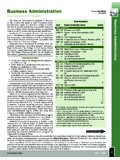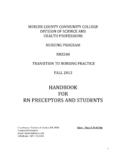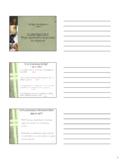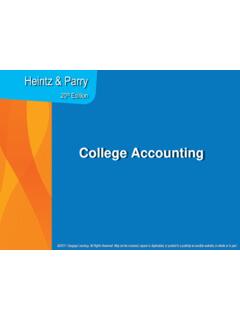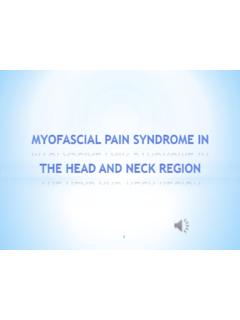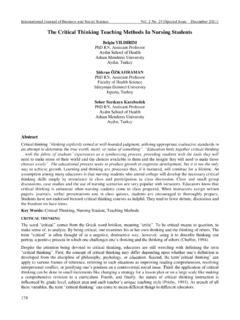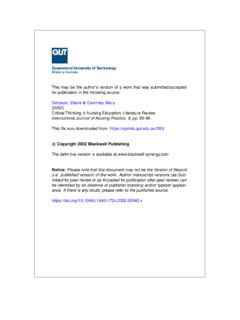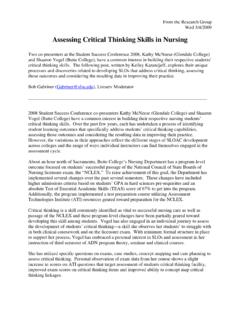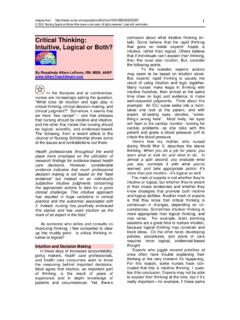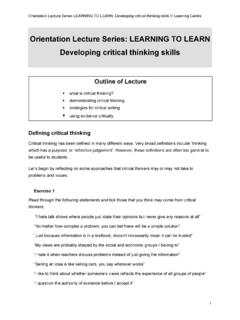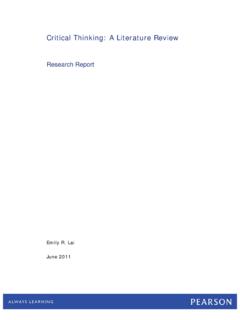Transcription of Thinking Like a Nurse: A Research-Based Model of Clinical ...
1 Thinking Like a nurse : A Research-Based Model of Clinical Judgment in NursingChristine A. Tanner, PhD, RNABsTRACTThis article reviews the growing body of research on Clinical judgment in nursing and presents an alternative Model of Clinical judgment based on these studies. based on a review of nearly 200 studies, five conclusions can be drawn: (1) Clinical judgments are more influenced by what nurses bring to the situation than the objective data about the situation at hand; (2) Sound Clinical judgment rests to some degree on knowing the patient and his or her typical pattern of responses, as well as an engagement with the patient and his or her concerns; (3) Clinical judg-ments are influenced by the context in which the situation occurs and the culture of the nursing care unit; (4) Nurses use a variety of reasoning patterns alone or in combina-tion; and (5) Reflection on practice is often triggered by a breakdown in Clinical judgment and is critical for the de-velopment of Clinical knowledge and improvement in clini-cal reasoning.
2 A Model based on these general conclusions emphasizes the role of nurses background, the context of the situation, and nurses relationship with their patients as central to what nurses notice and how they interpret findings, respond, and reflect on their judgment is viewed as an essential skill for virtually every health professional. Florence Nightingale (1860/1992) firmly established that observations and their interpretation were the hallmarks of trained nursing practice. In recent years, Clinical judg-ment in nursing has become synonymous with the widely adopted nursing process Model of practice. In this Model , Clinical judgment is viewed as a problem-solving activity, beginning with assessment and nursing diagnosis, pro-ceeding with planning and implementing nursing inter-ventions directed toward the resolution of the diagnosed problems, and culminating in the evaluation of the effec-tiveness of the interventions. While this Model may be useful in teaching beginning nursing students one type of systematic problem solving, studies have shown that it fails to adequately describe the processes of nursing judgment used by either beginning or experienced nurses (Fonteyn, 1991; Tanner, 1998).
3 In addition, because this Model fails to account for the complexity of Clinical judg-ment and the many factors that influence it, complete reli-ance on this single Model to guide instruction may do a significant disservice to nursing students. The purposes of this article are to broadly review the growing body of re-search on Clinical judgment in nursing , summarizing the conclusions that can be drawn from this literature, and to present an alternative Model of Clinical judgment that captures much of the published descriptive research and that may be a useful framework for of TeRMsIn the nursing literature, the terms Clinical judg-ment, problem solving, decision making, and critical Thinking tend to be used interchangeably. In this article, I will use the term Clinical judgment to mean an inter-pretation or conclusion about a patient s needs, concerns, or health problems, and/or the decision to take action (or not), use or modify standard approaches, or improvise new ones as deemed appropriate by the patient s response.
4 Clinical reasoning is the term I will use to refer to the processes by which nurses and other clinicians make their judgments, and includes both the deliberate process of Dr. Tanner is Youmans-Spaulding Distinguished Professor, Ore-gon & Health Science University, School of nursing , Portland, correspondence to Christine A. Tanner, PhD, RN, Youmans-Spaulding Distinguished Professor, Oregon & Health Sci-ence University, School of nursing , 3455 SW Veterans Hospital Road, Portland, OR 97239; e-mail: of nursing EducationTANNeRgenerating alternatives, weighing them against the evi-dence, and choosing the most appropriate, and those pat-terns that might be characterized as engaged, practical reasoning ( , recognition of a pattern, an intuitive clini-cal grasp, a response without evident forethought). Clinical judgment is tremendously complex. It is re-quired in Clinical situations that are, by definition, under-determined, ambiguous, and often fraught with value con-flicts among individuals with competing interests.
5 Good Clinical judgment requires a flexible and nuanced ability to recognize salient aspects of an undefined Clinical situa-tion, interpret their meanings, and respond appropriately. Good Clinical judgments in nursing require an under-standing of not only the pathophysiological and diagnostic aspects of a patient s Clinical presentation and disease, but also the illness experience for both the patient and fam-ily and their physical, social, and emotional strengths and coping resources. Adding to this complexity in providing individualized patient care are many other complicating factors. On a typical acute care unit, nurses often are responsible for five or more patients and must make judgments about priorities among competing patient and family needs (ebright, Patterson, Chalko, & Render, 2003). In addition, they must manage highly complicated processes, such as resolving conflicting family and care provider information, managing patient placement to appropriate levels of care, and coordinating complex discharges or admissions, amid interruptions that distract them from a focus on their Clinical reasoning (ebright et al.)
6 , 2003). Contemporary models of Clinical judgment must account for these com-plexities if they are to inform nurse educators approaches to oN Clinical JuDgMeNTThe literature review completed for this article updates a prior review (Tanner, 1998), which covered 120 articles retrieved through a CINAHL database search using the terms Clinical judgment and Clinical decision making, limited to english language research and nursing jour-nals. Since 1998, an additional 71 studies on these topics have been published in the nursing literature. These stud-ies are largely descriptive and seek to address questions such as:l What are the processes (or reasoning patterns) used by nurses as they assess patients, selectively attend to Clinical data, interpret these data, and respond or inter-vene?l What is the role of knowledge and experience in these processes?l What factors affect Clinical reasoning patterns? The description of processes in these studies is strongly re-lated to the theoretical perspective driving the research .
7 For example, studies using statistical decision theory describe the use of heuristics, or rules of thumb, in decision making, demonstrating that human judges are typically poor infor-mal statisticians (Brannon & Carson, 2003; O Neill, 1994a, 1994b, 1995). Studies using information processing theory fo-cus on the cognitive processes of problem solving or diagnos-tic reasoning, accounting for limitations in human memory (Grobe, Drew, & Fonteyn, 1991; Simmons, Lanuza, Fonteyn, Hicks, & Holm, 2003). Studies drawing on phenomenologi-cal theory describe judgment as an situated, particularistic, and integrative activity (Benner, Stannard, & Hooper, 1995; Benner, Tanner, & Chesla, 1996; Kosowski & Roberts, 2003; Ritter, 2003; White, 2003).Another body of literature that examines the processes of Clinical judgment is not derived from one of these tradi-tional theoretical perspectives, but rather seeks to describe nurses Clinical judgments in relation to particular Clinical issues, such as diagnosis and intervention in elder abuse (Phillips & Rempusheski, 1985), assessment and manage-ment of pain (Abu-Saad & Hamers, 1997; Ferrell, eberts, McCaffery, & Grant, 1993; Lander, 1990; McCaffery, Fer-rell, & Pasero, 2000), and recognition and interpretation of confusion in older adults (McCarthy, 2003b).
8 In addition to differences in theoretical perspectives and study foci, there are also wide variations in research methods. Much of the early work relied on written case scenarios, presented to participants with the requirement that they work through the Clinical problem, Thinking aloud in the process, producing verbal protocols for analy-sis (Corcoran, 1986; Redden & Wotton, 2001; Simmons et al., 2003; Tanner, Padrick, Westfall, & Putzier, 1987) or re-spond to the vignette with probability estimates (McDon-ald et al, 2003; O Neill, 1994a). More recently, research has attempted to capture Clinical judgment in actual prac-tice through interpretation of narrative accounts (Ben-ner et al., 1996, 1998; Kosowski & Roberts, 2003; Parker, Minick, & Kee, 1999; Ritter, 2003; White, 2003), observa-tions of and interviews with nurses in practice (McCarthy, 2003b), focused human performance interviews (ebright et al., 2003; ebright, Urden, Patterson, & Chalko, 2004), chart audit (Higuchi & Donald, 2002), self-report of deci-sion-making processes (Lauri et al.)
9 , 2001), or some com-bination of these. Despite the variations in theoretical perspectives, study foci, research methods, and resulting descriptions, some general conclusions can be drawn from this growing body of literature. Clinical Judgments Are More influenced by What the nurse Brings to the situation than the objective Data About the situation at handClinical judgments require various types of knowledge: that which is abstract, generalizable, and applicable in many situations and is derived from science and theory; that which grows with experience where scientific ab-stractions are filled out in practice, is often tacit, and aids instant recognition of Clinical states; and that which is highly localized and individualized, drawn from knowing the individual patient and shared human understanding (Benner, 1983, 1984, 2004; Benner et al., 1996, Peden-McAlpine & Clark, 2002).For the experienced nurse encountering a familiar situation, the needed knowledge is readily solicited; the June 2006, Vol.
10 45, No. 6205 Clinical jUDGMeNT MODeLnurse is able to respond intuitively, based on an immedi-ate Clinical grasp and just knowing what to do (Cioffi, 2000). However, the beginning nurse must reason things through analytically; he or she must learn how to recog-nize a situation in which a particular aspect of theoretical knowledge applies and begin to develop a practical knowl-edge that allows refinement, extensions, and adjustment of textbook knowledge. The profound influence of nurses knowledge and philosophical or value perspectives was demonstrated in a study by McCarthy (2003b). She showed that the wide variation in nurses ability to identify acute confusion in hospitalized older adults could be attributed to differenc-es in nurses philosophical perspectives on aging. Nurses unwittingly adopt one of three perspectives on health in aging: the decline perspective, the vulnerable perspective, or the healthful perspective. These perspectives influence the decisions the nurses made and the care they provided.
